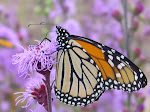
This book has been a major influence on me this spring. It is called Teaming with Microbes: A Gardener's Guide to the Soil Food Web by Jeff Lowenfels & Wayne Lewis (foreword by Elaine Ingham).
Back cover: "Discover how to create rich, nurturing, living soil-without resorting to harmful synthetic chemical."
This is a very approachable, practical, fascinating book on how beginning and experienced gardeners can gain an understanding of how we are all connected through the "soil food web". The soil food web is about the interrelationships between soil organisms, insects, plants, birds, animals and us. This idea can help heal the earth from the ground up, from a healthy "foundation".
We urban and suburban-ites often haul all our leaves and small twigs to the city compost. Many of us are unaware of any other use for leaves and twigs. We pretty much treat leaves as "leaf litter" or garbage. Many of us throw out our vegetable food scraps in the garbage. We want to live if a society that is sustainable and environmentally friendly, right? Well, now we can become empowered with the knowledge from this book in how to transform leaves, twigs, lawn clippings, and plant-based food scraps into compost. And this compost can help out soils "team with life".
This book explains to us how to use organic gardening techniques, make and use compost, select natural mulches and even create and use the mysterious "compost teas".
Compost tea has nothing to do with "tea" (like Oolong or Jasmine). Instead it is a compost concentrate that is packed full of beneficial aerobic microbes. Compost teas can be applied to vegetable gardens, native plantings, or old tired out wood lots.
What we throw out can be made into compost. The leaves can be used as mulch, can be composted to amend soils with, top dress gardens with....the leaves are now "brown gold". Vegetational food scraps can be composted in the back yard. In city and suburban lands, the soils are degraded, over-tilled, compacted, weed infested and tired or are often have too much synthetic chemicals applied to lawns and gardens. In some areas of the Twin Cities area, top soils with organic content do not exist. Often in housing developments from 1970's to the present, top soils need to be added back to properties. It has become clear to me that aged leaf compost is a safe, effective way to revitalize soils on smaller properties. Native woodland plantings, Oak savanna gardens and prairie gardens can all stand to benefit from a 2-3" layer of aged leaf compost for establishment.
I thoroughly enjoy this book and return to it often.

